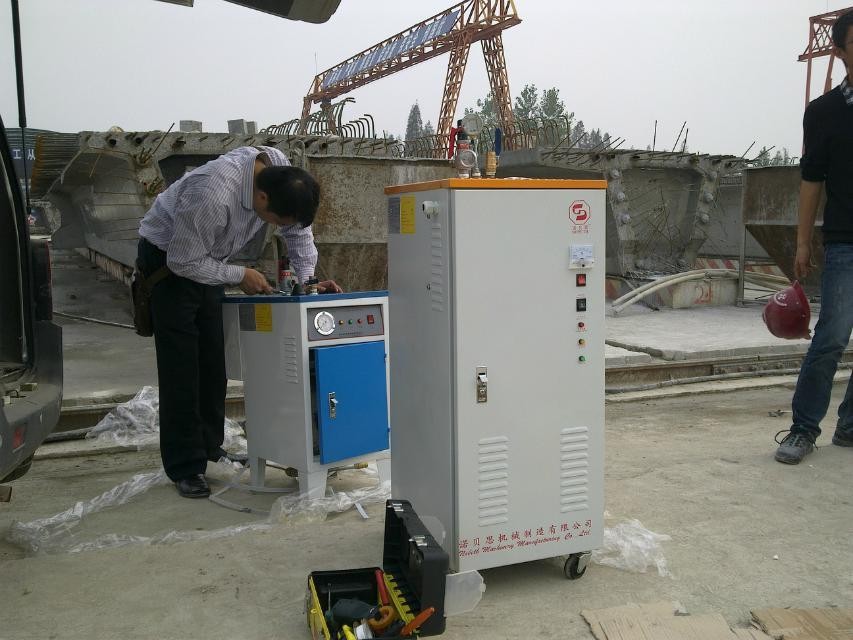Nobeth steam generator for cement brick maintenance
We know that the cement bricks produced by the cement brick machine can be naturally dried for 3-5 days before leaving the factory. So we just need to leave the finished bricks there to dry after they come out? Definitely not. To produce high-quality, high-strength cement bricks, maintenance is essential.
The maintenance temperature and humidity of cement bricks must be well controlled. There are many types of maintenance, including natural maintenance, solar maintenance, steam maintenance, dry heat maintenance, carbonization maintenance, immersion maintenance and other maintenance methods. Among them, steam curing can meet the multiple needs of the enterprise’s production process.
I won’t go into detail about natural curing and solar curing. The methods are relatively simple and are commonly used in various brick factories. The steam curing introduced to you today is a better and relatively high-efficiency solution to increase output among these methods.Steam curing is to put the formed blocks (that is, cement bricks) into a steam environment to harden quickly. The relative humidity must be maintained above More than 90%, and the temperature should not be higher than 30~60℃. For tailings concrete cement bricks using cement as the cementing material, steam curing under normal pressure conditions is generally used.
After steam curing, the concrete can harden quickly and reach 60% strength after one cycle (that is, 8 hours), thus greatly improving production efficiency. The strength of cement bricks is also greatly improved, truly improving the efficiency of enterprises. , the goal of gathering production capacity.
In cement brick factories, using steam generators for maintenance also has the following advantages:
1. Environmentally friendly steam generators can reduce exhaust gas emissions and achieve the effect of purifying emissions.
When the industrial steam generator is working, the heated flue gas enters the heating tube of the boiler to heat the high-temperature flue gas. The high-temperature flue gas exchanges heat with water, causing the temperature of the flue gas to increase. At the same time, the steam passes through the nozzle and is in direct contact with the inner wall of the furnace, causing the flue gas to enter the furnace, and with the water vapor mist, the water vapor forms water vapor in the furnace to protect the furnace from overheating, increase the pressure in the furnace, and reduce the temperature of the flue gas, thereby achieving purification Smoke and reduce smoke and dust emissions. And as the water vapor continues to rise, the water vapor continues to rise and the flue gas temperature increases, and the flue gas emissions will be greatly reduced. It can also cool the flue gas and make it meet energy-saving emission standards.
2. It can protect the environment well and reduce environmental pollution.
In order to improve the quality of bricks, many brick factories treat a large amount of wastewater generated during the production process. This part of wastewater can be discharged directly into farmland or rainwater pipes, but due to the pollution of the wastewater itself, it can also be discharged into industrial production areas. If there are industrial boilers or kilns, treating the wastewater and then transporting it to farmland or rainwater pipes will naturally reduce wastewater pollution and environmental pollution, and protect the environment well. At the same time, it will not affect the normal operation of the factory. Because the brick factory uses industrial steam to generate high-temperature water vapor for drying, the presence of industrial steam in the production wastewater can reduce the wastewater from being discharged into farmland or rainwater pipes again.
3. The raw water vapor can be directly heated to 80 degrees, which can reduce fuel consumption and avoid danger caused by high temperature.
At the same time, waste gas can also be recycled. For enterprises, the biggest problem is that the cost and risk are too high. Environmental protection can be achieved by using a steam generator to heat the raw water and then replacing the air with raw water. And the use of steam generators does not require the treatment of pollutants emitted from coal-fired boilers. Therefore, if you want to use it, you must make the right choice before producing it. Nowadays, China has become the largest economy in the world, and energy prices are also rising. With so many costs, if you want to use steam generators to recycle the environment and resources, you must use them in the production process. to reduce pollution and harm to the environment. Therefore, everyone should understand the environmental benefits of steam generators and their contribution to the clean energy industry. Therefore, for those who want to realize their dream of saving energy and reducing consumption by burning kilns, using a steam generator can be said to be the best choice!
4. No open flames are emitted during the work, and there is no emission of waste gas and waste water.
In addition, no harmful substances such as smoke and dust are produced during work, and the impact on the environment is relatively small. Industrial steam generators not only protect the environment, but are also of great help to brick-making enterprises. Because both bricks and lime produce some lime during the production process, after heating, the lime will dissolve into water vapor and then condense into a white solid. This solid is called water vapor, but this solid substance It is a product that is difficult to burn. Therefore, if these solid materials are made into steam generators, these liquid fuels can become easier to burn, so industrial steam can help companies recycle these wastes. For example, these wastes are heated with gas generated by steam and then reused. The gas can be used as industrial fuel or in the production of brick-making equipment, or as a collection device for dust or wastewater generated during industrial production, etc.
